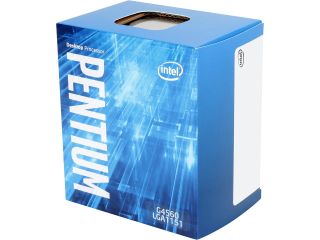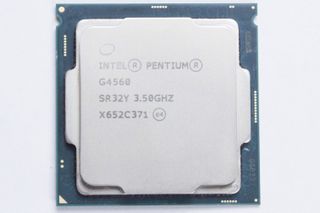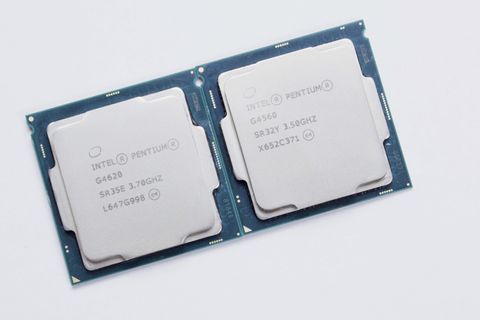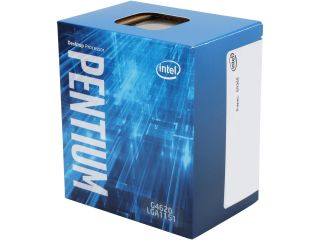Early Verdict
Budget gaming builds always strive to optimize for performance per dollar. The Pentium G4560 stacks that equation in your favor like no processor before it. A slightly lower clock rate compared to the G4620 saves quite a bit of money, yet it's still fast enough for modern games and most desktop productivity apps. If a discrete graphics card is on your shopping list, the Pentium G4560's low cost might help you level-up to a faster GPU, too.
Pros
- +
Hyper-Threading
- +
Price
Cons
- -
HD Graphics 610
- -
Locked multiplier
- -
No AVX/AVX2 support
- -
Lower performance than Core i3/i5
Why you can trust Tom's Hardware
Intel's Pentium CPUs Get Hyper-Threading
Enthusiasts and casual users alike have suffered from the slow trickle of CPU innovation over the last several years. Each new generation brings smaller improvements, and lately, stagnant pricing. Intel's 14nm Kaby Lake architecture, which marks the company's transition to an extended tick-tock-tock cadence, sets the stage for even less excitement from each generation. We appreciate faster transistors that provide higher clock rates, along with Intel's improved media capabilities, but the rewarmed Skylake design won't inspire anyone with a fairly modern PC to upgrade.

Although the high-end processors give us little to talk about, Intel's recent realignment of the Core i3 and Pentium families are a bit more newsworthy. First, the company launched an unlocked Core i3-7350K, and though it doesn't offer the value we expect from an i3, it is a fun chip for tuners.
Intel also infused the Kaby Lake-based Pentiums with 100-200 MHz of extra frequency. More important, they now enjoy the benefit of Hyper-Threading technology. In the past, Hyper-Threading was a key differentiator between the Core i3 and Pentium CPUs, but the dual-core chip's ability to operate on four threads simultaneously could put today's Pentiums on-par with some of yesterday's low-end Core i3s. Hyper-Threading can boost performance up to 30%, and though we usually see ~20% gains in applications optimized for parallelization (mileage varies, of course), this move also opens the door to games that require four threads.
Kaby Lake Pentiums still include 3MB of last-level cache shared across the die, which is another differentiating feature compared to the 4MB-equipped Core i3s. Thankfully, the Pentiums do include a heat sink, which will help value-seekers keep costs down.


The 51W Pentium G4620 is the family's highest-end model. Its 3.7 GHz base frequency is only 100 MHz higher than the previous-gen G4520. As with all Pentiums, Turbo Boost is not supported. The chip does feature HD Graphics 630, though, and the Gen 9.5 graphics architecture provides fixed-function hardware for HEVC 10-bit decode/encode, VP9 8/10-bit decode, and VP9 8-bit encode. The G4620 offers promising performance, but its $93 price tag comes uncomfortably close to the Core i3 series.

The 54W Pentium G4560 appears to offer better value with its 3.5 GHz base clock rate and $64 price tag. That's 31% less money for a 200 MHz sacrifice. The G4560 even challenges low-end Core i3 CPUs. Although it operates at a lower frequency than the 3.9 GHz Kaby Lake i3-7100 and 3.7 GHz Skylake i3-6100, it retails for $53 less. The Pentium G4560 drops you back to HD Graphics 610 with a lower 1050 GHz turbo clock rate, but most Tom's Hardware readers will probably pair the Pentium with a mainstream add-in graphics card.
Intel did make a few adjustments to prevent the Pentiums from plundering sales of its own more expensive models. The company nixed support for AVX/AVX2 instructions and TSX-NI, though we don't expect those omissions to hurt low-cost gaming machines much. It also trimmed Optane support, which is one of the few reasons to upgrade to a 200-series motherboard. We don't know what price Intel's Optane caching will command when it comes to market later this year, but we're fairly confident that the technology won't be aimed at entry-level machines. Although the H270 and B250 platform controller hubs offer more connectivity than their predecessors due to increased HSIO lane allocations, if you don't need those features, low-cost 100-series motherboards are plenty attractive (and less expensive).
Some games benefit more from high clock rates more than any other specification, and most titles played on a mainstream gaming system will be graphics-bound before a CPU bottleneck rears its ugly head. Either one of the Pentiums we're reviewing complement low-cost motherboards and sub-$200 graphics cards for reasonable 1080p performance. But at the price points we're talking about, we want to really optimize for value. Let's see if the G4620's slightly higher clock rate is worth the big premium.
MORE: Best CPUs

Paul Alcorn is the Managing Editor: News and Emerging Tech for Tom's Hardware US. He also writes news and reviews on CPUs, storage, and enterprise hardware.
-
lhsbrandon Why do you use an old Piledriver based Athlon? I would think the newer models would be a little more competitive.Reply -
Sam Bittermann ReplyWhy do you use an old Piledriver based Athlon? I would think the newer models would be a little more competitive.
Because we know what the outcome would be, which is the same. Slowest of the bunch overall. -
Onus I would like to have seen the G3258 overclocked to 4.0GHz (even bad silicon should reach that; I got 4.2GHz with a better sample). After all, a lot of people who bought that chip specifically intended to overclock it, which they could do even on H81 boards. That's an 800MHz bump over stock, which should be substantial. We'll still see where lack of hyperthreading hurts, but we'll get a better picture of what this chip can do.Reply -
TJ Hooker ^agree, especially given that they OCed the Athlon, OCing the G3258 would have made sense.Reply
I also would have preferred an i3-6100 rather than a 6320 in the results, given that the 6100 is the closest in specs to the new Pentiums, making it the natural choice for comparing Pentiums w/ HT to an i3. Also, the 6100 was the go-to budget gaming CPU recommendation since Skylake came out (don't think I've ever seen anyone recommend a 6320), a title which the G4560 is poised to steal. Although obviously the 6100 and 6320 perform pretty similarly, so it's not a huge deal. -
Walter_35 This is exactly what I was hoping for. Looks like for budget gaming, the 4560 is good enough and allows for a better GPU in the same budget. But for more professional applications, you still might want to make the jump to an i3 to get those AVX(2) instructions and in many cases this step up could be payed for by skipping the dGPU.Reply -
TechyInAZ Reply19342093 said:Is it just me or are all the gaming benchmarks missing?
Your probably on the wrong picture, use the arrow buttons to show the actual FPS benchmarks. -
anbello262 "The 54W Pentium G4650 appears to offer better value with its 3.5 GHz base clock rate and $64 price tag."Reply
I think that should read "The 54W Pentium G4560" -
PaulAlcorn Reply19342878 said:"The 54W Pentium G4650 appears to offer better value with its 3.5 GHz base clock rate and $64 price tag."
I think that should read "The 54W Pentium G4560"
Good catch, fixed!
-
warmon6 Reply19342227 said:Why do you use an old Piledriver based Athlon? I would think the newer models would be a little more competitive.
As an owner of the A10-7850k apu that has over (Equal to the Athlon X4 860k) that have the steamroller cores, the difference is not that big at the same clock speeds.
and base on anandtech review of the Athlon x4 845 (based on the Excavator core) when all generations of athlon bulldozer are benched marked together, the story doesn't change much there either.
http://www.anandtech.com/show/10436/amd-carrizo-tested-generational-deep-dive-athlon-x4-845/10


